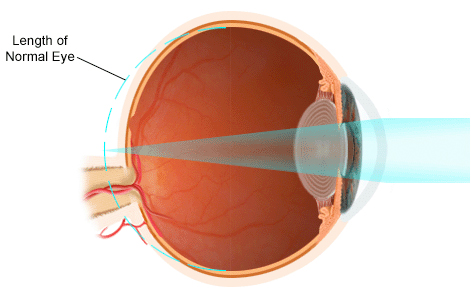Farsightedness (Hyperopia)
Farsightedness also known as hyperopia or hypermetropia, as it is medically termed, is a weakness of vision caused by an imperfection in the eye. This defect is due to the eyeball being too short or when the lens of the eye is not round enough or too flat causing great difficulty in focusing on objects nearby. As an object draws closer to the eye, the eye must increase its power to keep images in focus. If the function of the cornea or the lens is not sufficient, as in farsightedness, images will appear blurry. Individuals with farsightedness may experience blurred vision, asthenopia, accommodative dysfunction, binocular dysfunction, amblyopia, and strabismus. Patients with farsightedness can usually see distant images very clearly, but have trouble focusing on objects nearby or close.

The causes of farsightedness or hyperopia are normally genetic and involve an eye that is too short or a cornea that is too flat, so that images focus at a point behind the retina. Farsightedness or hyperopia, occurs when light entering the eye focuses behind the retina, instead of directly on it. Farsightedness often runs is hereditary. In some rare cases, diseases such as retinopathy and eye tumors can lead to farsightedness. So can a problem with the lens of the eye.
Young people with mild to moderate hyperopia can often see clearly because their natural lens can adjust accordingly, or accommodate to increase the eye's focusing ability and power. However, as the eye gradually loses the ability to make this adjustment, beginning normally at about 40 years of age, blurred vision from hyperopia often becomes more and more apparent.
Signs and symptoms include difficulty seeing up close, blurred distance vision (occurs with higher amounts of hyperopia), eye fatigue when reading, eye strain (headaches, pulling sensation, burning) and potentially crossed eyes in children. Hyperopia is usually detected with a vision test called a refraction. In younger patients, the eyes are dilated for this test so they are unable to mask their farsightedness with accommodation. This is called a wet refraction. It is important to note that common vision screenings, often done in schools, are generally ineffective in detecting farsightedness in younger patients. A comprehensive optometric examination is required for testing for and diagnosing farsightedness.
The treatment for hyperopia depends on several factors such as the age of the patient and a patients' activities and occupation. Your eye doctor or optometrist can tell if you are farsighted by doing a comprehensive eye examination. Normally, the optometrist will also ask about your past health before beginning the vision test to determine any patterns. Young patients may or may not require glasses or contact lenses, depending on their ability to compensate for their farsightedness and their abilty to for the retina to make the adjustments. However, eyeglasses or corrective contact lenses are normally required for older patients. Mild farsightedness often doesn't need treatment as the eyes can normally adjust to make up for the problem. But as you age, your eyes will not be able to adjust as well, and eyeglasses or corrective contact lenses are typically required. Corrective Glasses or contact lenses can also help if your farsightedness is more than just a mild problem.
Surgery may be an option in some cases. Several types of surgery are available to treat farsightedness. The purpose of the surgery is to reshape the cornea so that light is refocused directly on the retina rather than behind it. The ultimate goal of surgery is to allow people who are farsighted to see clearly without corrective lenses or to be a lot less dependent on them. Most doctors consider 20/40 vision or better after surgery a satisfactory result. People with 20/40 vision or better are allowed to drive a car without eyeglasses or contact lenses.
Laser surgery for farsightedness is not as common as surgery to correct nearsightedness, myopia. This is because the cornea must be reshaped and steepened to correct farsightedness, which is more difficult than it is to flatten it, as is done to correct nearsightedness. Therefore, LASIK is done for milder degress of farsightedness. Other options are also available, such as thermal keratoplasty (including conductive keratoplasty). But these options can cause corneal scarring which is permanent and can never be rectified.
Other procedures used to treat farsightedness include phakic intraocular lenses and clear lens extraction with intraocular lens implant. These options can correct high degrees of farsightedness. Both of these procedures involve implanting an intraocular lens (IOL) into the eye. As clear lens extraction leads to the loss of the ability to accommodate, this may be the best option for older people with severe farsightedness who have already naturally lost their ability to focus on objects nearby.
For additional information or to schedule an Eye Examination, please contact us at (866) 611-7556.
Also Serving:
Sealy, TX - Bellville, TX - Columbus, TX - Katy, TX |
